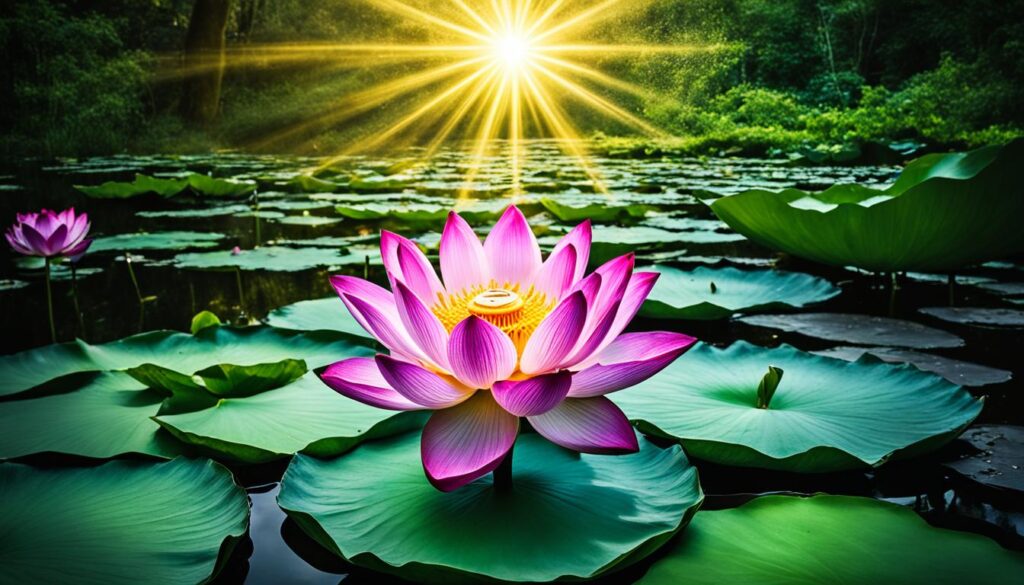Have you ever wondered what it would feel like to experience true spiritual liberation? To break free from the chains of attachment and desire, and discover a profound sense of inner peace and transcendence? Moksha, the concept of ultimate freedom and liberation, offers you the key to unlocking these transformative experiences.
Moksha holds great significance in Hinduism and other Eastern spiritual traditions, offering individuals a path towards self-realization and the realization of the oneness of all life. But what exactly is moksha, and how can you achieve it? Let’s explore the deep meaning and paths to moksha, uncovering the secrets that can lead you to the liberation you seek.
Key Takeaways:
- • Moksha is the ultimate goal of human life, offering liberation from the cycle of birth, death, and rebirth.
- • Achieving moksha involves understanding the true nature of oneself, breaking free from desires and attachments, and realizing the oneness of all life.
- • Hinduism and Buddhism provide different paths to moksha, including self-discipline, knowledge, devotion, meditation, and ethical behavior.
- • Maya and karma play crucial roles in the journey to moksha, requiring individuals to overcome illusion and purify their actions.
- • The pursuit of moksha extends beyond Hinduism and Buddhism, with various spiritual paths and practices offering insights and techniques for achieving liberation.
Understanding Moksha: The Essence of Liberation
Moksha, derived from the Sanskrit word “mokṣa,” is a fundamental concept in Indian philosophy and spirituality. Often translated as “liberation,” “freedom,” or “bliss,” moksha holds profound significance for those seeking spiritual transcendence and inner peace.
In its essence, moksha represents the attainment of a state of ultimate liberation from the cycle of birth, death, and rebirth. It involves transcending the ego, desires, and the karmic consequences of one’s actions. Rather than being a physical destination, moksha is a state of being, characterized by non-ego, oneness, and freedom from all desires and attachments.

To achieve moksha, individuals can follow various paths, each offering unique insights and practices. These paths include:
- Self-discipline: Through self-discipline, one can cultivate restraint, control over the senses, and the ability to let go of attachment to material possessions and desires.
- Knowledge: The pursuit of knowledge, particularly spiritual wisdom and self-realization, plays a vital role in the journey towards moksha. Understanding the true nature of oneself and the interconnectedness of all life is paramount.
- Devotion: Devoting oneself to a higher power or spiritual ideal creates a deep sense of love, surrender, and connection. This path involves heartfelt devotion, rituals, and rituals to experience the divine within and without.
- Meditation: Meditation practices, such as mindfulness and contemplation, help quiet the mind and lead to self-realization. Meditation allows individuals to directly experience their true nature and dissolve the illusion of duality.
The paths to moksha are not mutually exclusive; they can complement and intertwine with each other. Personal inclination, temperament, and spiritual tradition often determine the preferred path. It is a transformative journey that requires discipline, self-awareness, and a genuine yearning for spiritual liberation.
The Path to Moksha in Hinduism
In Hinduism, moksha is considered the ultimate goal of human life. It is the state of spiritual liberation, where the soul breaks free from the cycle of birth and death and attains eternal bliss. Achieving moksha requires a deep understanding of the self and the realization of the divine nature within.
There are several paths in Hinduism that can lead an individual towards moksha. These paths encompass various aspects of life and spirituality, providing a holistic approach to attaining liberation.
The Path of Dharma
Dharma refers to the righteous duties and responsibilities that each individual must fulfill in their life. By living in accordance with their dharma, individuals create harmony and contribute to the overall well-being of society. Following the path of dharma helps purify the soul and creates favorable conditions for achieving moksha.
The Path of Self-Discipline
Self-discipline, known as yama and niyama, is an essential aspect of the path to moksha. It involves practicing ethical values, such as honesty, truthfulness, non-violence, and contentment. Cultivating self-discipline helps individuals overcome their desires and attachments, allowing them to experience inner peace and liberation.
The Path of Knowledge
Jnana, or knowledge, plays a vital role in the journey to moksha. It refers to the understanding of the self, the nature of reality, and the interplay between the material and spiritual realms. By seeking knowledge through study, reflection, and contemplation, individuals can gain insights that lead to spiritual awakening and ultimate liberation.
The Path of Selfless Action
Karma yoga, the path of selfless action, involves performing one’s duties without attachment to the results. By engaging in actions that benefit others and contribute to the greater good, individuals purify their minds and cultivate a spirit of selflessness. This path helps break free from the bondage of ego and desires, paving the way for moksha.
The Path of Devotional Love
Bhakti yoga, the path of devotional love, emphasizes establishing a deep and intimate connection with the divine. Through prayer, worship, and surrendering of the ego, individuals develop a profound love for the divine and seek union with it. The path of bhakti allows individuals to transcend their limited selves and merge with the divine, ultimately leading to moksha.
By following these paths and embodying the principles of dharma, self-discipline, knowledge, selfless action, and devotional love, individuals can embark on a transformative journey towards moksha in Hinduism. It is a path of self-discovery, inner growth, and liberation from the cycles of life and death.

| Paths to Moksha in Hinduism | Description |
|---|---|
| Path of Dharma | Fulfilling righteous duties and responsibilities |
| Path of Self-Discipline | Practicing ethical values and overcoming desires |
| Path of Knowledge | Seeking understanding of the self and reality |
| Path of Selfless Action | Performing duties without attachment to results |
| Path of Devotional Love | Cultivating love and surrender to the divine |
Moksha in Buddhism: Liberation from Suffering
In Buddhism, the concept of moksha is synonymous with the state of nirvana, which represents liberation from suffering. To achieve moksha and break free from the cycle of birth and death, Buddhists follow the teachings of the Four Noble Truths and the Eightfold Path.
The Four Noble Truths serve as the foundation of Buddhist philosophy and address the nature of suffering (dukkha) and its causes. Through understanding and insight into these truths, individuals can overcome suffering and ultimately achieve moksha.
- The Truth of Suffering: Recognize the existence of suffering in life, which includes physical pain, psychological distress, and the unsatisfactory nature of conditioned existence.
- The Truth of the Origin of Suffering: Understand that attachment, desire, and ignorance are the root causes of suffering. By acknowledging and transcending these causes, individuals can attain liberation.
- The Truth of the Cessation of Suffering: Realize that liberation from suffering is possible, and it can be achieved through the cessation of attachment, desire, and ignorance.
- The Truth of the Path to the Cessation of Suffering: Follow the Eightfold Path, a set of ethical guidelines and practices, to attain liberation from suffering and achieve moksha.
The Eightfold Path consists of the following interconnected aspects:
- Right View: Developing a proper understanding of reality and the nature of existence.
- Right Intention: Cultivating wholesome intentions and renouncing harmful desires.
- Right Speech: Speaking truthfully, kindly, and non-harmfully.
- Right Action: Engaging in ethical conduct and refraining from harming others.
- Right Livelihood: Choosing a livelihood that is ethical and contributes positively to society.
- Right Effort: Cultivating wholesome qualities and letting go of unwholesome ones.
- Right Mindfulness: Cultivating present-moment awareness and mindfulness in all activities.
- Right Concentration: Developing focused and concentrated meditation to gain insight and wisdom.
Buddhism emphasizes the importance of personal responsibility and direct experience in realizing moksha. By following the Eightfold Path and practicing mindfulness, compassion, ethical behavior, and meditation, individuals strive to liberate themselves from suffering and achieve the ultimate goal of moksha.

| Path to Moksha in Buddhism | Description |
|---|---|
| Four Noble Truths | The foundation of Buddhist philosophy addressing the nature, cause, cessation, and path to the cessation of suffering. |
| Eightfold Path | A set of ethical guidelines and practices aimed at achieving moksha through right view, intention, speech, action, livelihood, effort, mindfulness, and concentration. |
| Mindfulness | Practicing present-moment awareness and cultivating mindfulness to gain insight and wisdom. |
| Compassion | Cultivating empathy, kindness, and compassion towards oneself and others. |
| Meditation | Developing focused concentration through various meditation techniques to gain deeper insights and liberate the mind from suffering. |
Paths to Moksha: Yogic Practices and Self-Realization
The pursuit of moksha, the ultimate liberation from the cycle of birth and death, extends beyond Hinduism and Buddhism. It encompasses various spiritual paths and practices that offer insightful techniques for achieving liberation. Among these paths, yoga, Jainism, and Sikhism hold profound wisdom and teachings. However, it is yoga in particular that provides a comprehensive system of practices for self-realization and attaining moksha.
Yoga embraces a holistic approach, incorporating physical postures (asanas), breath control (pranayama), meditation, and ethical principles (yamas and niyamas). These practices help individuals cultivate self-awareness, inner balance, and establish a deeper connection with the divine.
The Components of Yoga on the Path to Moksha
Yoga comprises several essential components that synergistically contribute to the journey of self-realization and moksha:
- Asanas: Physical postures in yoga promote physical strength, flexibility, and overall well-being. Asanas also prepare the body for deep meditation and help release pent-up energy and tensions.
- Pranayama: Breath control exercises harmonize and regulate the flow of life force energy (prana) within the body. Developing conscious control over the breath enhances mental focus and cultivates a calm and serene state of mind.
- Meditation: The practice of meditation serves as a powerful tool to quiet the mind, gain self-awareness, and experience higher states of consciousness. Regular meditation deepens one’s connection with the divine and facilitates self-realization.
- Yamas and Niyamas: The ethical principles in yoga, known as yamas (restraints) and niyamas (observances), guide individuals in their behavior towards themselves and others. These principles include principles such as honesty, non-violence, discipline, self-study, and contentment, fostering inner harmony and spiritual growth.

Incorporating these yogic practices into daily life provides individuals with invaluable tools to cultivate self-awareness, find balance, and embark on the path towards self-realization and moksha. Whether through yoga, Jainism, or Sikhism, the journey towards moksha holds the potential for profound inner transformation, leading to ultimate spiritual liberation.
| Paths to Moksha | Description |
|---|---|
| Yoga | A comprehensive system of practices involving asanas, pranayama, meditation, and ethical principles that cultivate self-realization and a deeper connection with the divine. |
| Jainism | The path of non-violence (ahimsa), truthfulness (satya), self-discipline (tapas), and non-attachment (aparigraha) leads individuals towards liberation from the cycle of rebirth. |
| Sikhism | The path of faith (shradha), righteous living (dharam), selfless service (seva), and meditation on the divine name (simran) guides individuals towards spiritual liberation. |
The Significance of Maya and Karma in the Journey to Moksha
Maya and karma are fundamental concepts that hold immense importance in the pursuit of moksha. Maya refers to the illusion or ignorance that distorts our perception of reality, keeping us trapped in the material world. It represents our attachment to the ego and the endless desires that bind us. To progress towards moksha, it is crucial to overcome Maya by recognizing the interconnectedness of all life and awakening to the true nature of oneself.
Karma, on the other hand, is the law of cause and effect that governs the consequences of our actions. Every action produces a karmic reaction that binds us to the cycle of rebirth. To realize moksha, it is necessary to understand and purify one’s karma. By cultivating selflessness, performing righteous actions, and detaching from the fruits of our actions, we can gradually free ourselves from the karmic cycle and progress on the path to liberation.
The Illusion of Maya
Maya is the veil that obstructs our perception of the ultimate truth. It deludes us into believing in the separateness of individuals and objects, fostering attachment and desires that perpetuate suffering. Overcoming Maya requires a deeper understanding of the interconnectedness of all life. By transcending the limited boundaries of the ego and embracing the unity of existence, we can break free from the illusionary nature of Maya and move closer towards moksha.
The Influence of Karma
Karma, the law of cause and effect, governs the consequences of our thoughts, words, and actions. It shapes the experiences we encounter in this life and determines our future births. To progress on the path to moksha, it is imperative to understand and purify our karma. By cultivating virtuous actions, performing selfless service, and practicing mindfulness, we can gradually neutralize the karmic imprints that bind us, opening the doors to spiritual liberation.
In summary, Maya and karma are integral aspects of the journey towards moksha. Overcoming Maya’s illusion and purifying our karma are essential steps in transcending the cycle of birth and death. By recognizing the interconnectedness of all life and aligning our actions with righteousness and selflessness, we can embark on the transformative path to moksha and experience the ultimate liberation of the soul.
The Path to Moksha: Self-Mastery and Inner Harmony
Self-mastery and inner harmony are the fundamental pillars on the path to achieving moksha, the ultimate state of liberation. To embark on this transformative journey, one must first master their desires, ego, and attachments. It requires a deep understanding of oneself and a commitment to breaking free from the chains of external influences.
Through self-reflection and introspection, you can gain insight into your true nature and the patterns that hold you back. This self-awareness allows you to identify and transcend limiting beliefs, paving the way for personal growth and self-realization.
One of the most powerful tools on this path is meditation. By quieting the mind and turning inward, you can cultivate a sense of inner peace and clarity. Meditation not only helps you detach from external distractions but also enables you to observe your thoughts and emotions without judgment. This practice promotes self-control and helps you develop a deep sense of presence.
Another essential aspect of the journey to moksha is selfless service. By offering your time and energy to others, you cultivate compassion and expand your capacity for empathy. Engaging in acts of kindness and charity not only benefits those in need but also brings fulfillment and a sense of purpose to your own life.
The cultivation of virtues such as compassion, love, and equanimity is vital on the path to moksha. These qualities help you create inner harmony and foster positive relationships with others. As you practice forgiveness, embrace acceptance, and let go of judgment, you create a space for inner peace and connection.
The Path to Self-Mastery and Inner Harmony:
- Cultivate self-awareness through self-reflection and introspection.
- Practice meditation to quiet the mind and foster inner peace.
- Engage in selfless service to cultivate compassion and empathy.
- Cultivate virtues such as love, compassion, and equanimity.
The journey to moksha is a lifelong endeavor, requiring dedication, discipline, and unwavering commitment. It is a path of continuous growth, self-discovery, and transcendence. By mastering your desires, cultivating inner harmony, and embracing the interconnectedness of all beings, you can achieve moksha and experience the profound liberation it brings.
Conclusion
The quest for moksha, spiritual liberation, is a universal longing that transcends religious boundaries. It offers individuals the opportunity to find true freedom, inner peace, and transcendence. Whether through the teachings of Hinduism, Buddhism, or other spiritual traditions, the path to moksha involves self-realization, the mastery of desires and ego, and the realization of the interconnectedness of all life. By embarking on this transformative journey, you can embrace your path to moksha and experience the profound liberation it brings.
Through self-reflection, meditation, and the practice of virtues such as compassion and love, you can cultivate inner harmony and self-mastery. The path to moksha requires dedication and discipline, but it offers unimaginable rewards. By breaking free from the bonds of attachment, desires, and ignorance, you can achieve a state of oneness and transcend the cycle of birth and death.
Remember that the journey to moksha is unique for each individual. You may find your path through devotion, selfless service, knowledge, or meditation. The important thing is to remain committed to your spiritual growth and strive for self-realization. By embracing your path to moksha, you can unlock the door to ultimate freedom and experience the profound liberation of the soul.
FAQ
What is moksha?
Moksha, also known as spiritual liberation, refers to the state of ultimate freedom and liberation from the cycle of birth, death, and rebirth in Hinduism and other Eastern spiritual traditions.
How do you achieve moksha?
Achieving moksha involves understanding the true nature of oneself, breaking free from the bonds of attachment and desire, and realizing the oneness of all life.
What is the significance of moksha?
Moksha offers individuals a path towards inner peace, bliss, and transcendence. It is a profound concept that holds great importance in Hinduism and other spiritual traditions.
What are the paths to moksha?
The paths to moksha vary across different traditions but can include self-discipline, knowledge, devotion, and meditation.
How does Hinduism view moksha?
In Hinduism, moksha is considered the ultimate goal of human life. It is achieved through fulfilling one’s duties, practicing self-discipline, cultivating knowledge, engaging in selfless action, and experiencing devotional love.
How is moksha understood in Buddhism?
In Buddhism, moksha is synonymous with the state of nirvana—the liberation from suffering. It is achieved through understanding and overcoming the root causes of suffering and practicing mindfulness, compassion, ethical behavior, and meditation.
Are there other paths to moksha?
Yes, various spiritual paths and practices such as yoga, Jainism, and Sikhism also offer insights and techniques for achieving liberation. Yoga, in particular, provides a comprehensive system of physical postures, breath control, meditation, and ethical principles that can lead to self-realization and moksha.
What is the role of Maya and Karma in the journey to moksha?
Maya refers to the illusion or ignorance that distorts our perception of reality, while karma refers to the law of cause and effect. Overcoming Maya involves recognizing the interconnectedness of all life, and purifying one’s karma is essential for progressing towards moksha.
What is the significance of self-mastery and inner harmony in the path to moksha?
Self-mastery and inner harmony are essential aspects of the path to moksha. They involve the mastery of desires, ego, and attachments, as well as finding balance and harmony within oneself through self-reflection, meditation, and the cultivation of virtues.
What does the quest for moksha offer individuals?
The quest for moksha offers individuals the opportunity to find true freedom, inner peace, and transcendence regardless of religious boundaries. It is a transformative journey that leads to self-realization and the experience of profound liberation.

